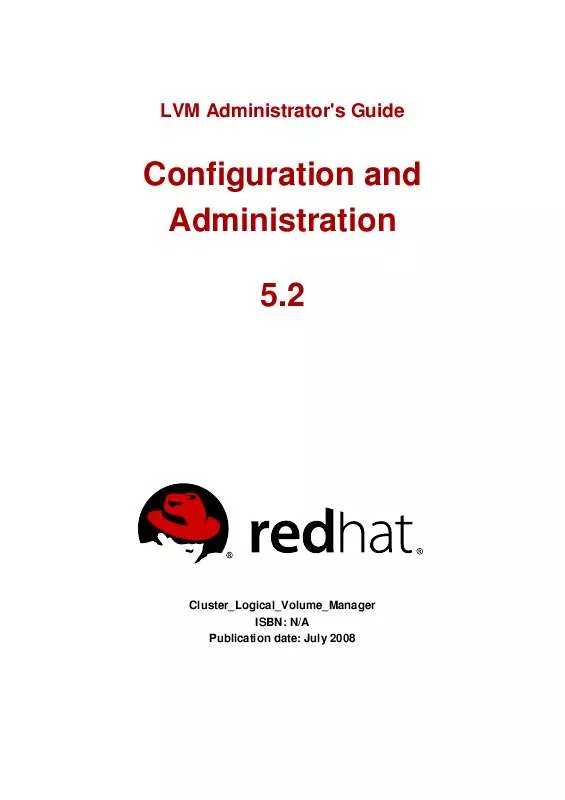User manual REDHAT LVM ADMINISTRATOR 5.2 CONFIGURATION
Lastmanuals offers a socially driven service of sharing, storing and searching manuals related to use of hardware and software : user guide, owner's manual, quick start guide, technical datasheets... DON'T FORGET : ALWAYS READ THE USER GUIDE BEFORE BUYING !!!
If this document matches the user guide, instructions manual or user manual, feature sets, schematics you are looking for, download it now. Lastmanuals provides you a fast and easy access to the user manual REDHAT LVM ADMINISTRATOR 5.2. We hope that this REDHAT LVM ADMINISTRATOR 5.2 user guide will be useful to you.
Lastmanuals help download the user guide REDHAT LVM ADMINISTRATOR 5.2.
Manual abstract: user guide REDHAT LVM ADMINISTRATOR 5.2CONFIGURATION
Detailed instructions for use are in the User's Guide.
[. . . ] LVM Administrator's Guide
Configuration and Administration 5. 2
Cluster_Logical_Volume_Manager ISBN: N/A Publication date: July 2008
LVM Administrator's Guide
This book describes the LVM logical volume manager for Red Hat Enterprise Linux 5. 2, including information on running LVM in a clustered environment. The content of this document is specific to the LVM2 release.
LVM Administrator's Guide: Configuration and Administration
Copyright © 2008 Red Hat, Inc.
Copyright © 2008 Red Hat, Inc. This material may only be distributed subject to the terms and conditions set forth in the Open Publication License, V1. 0 or later with the restrictions noted below (the latest version of the OPL is presently available at http://www. opencontent. org/openpub/). Distribution of substantively modified versions of this document is prohibited without the explicit permission of the copyright holder. [. . . ] Removing Logical Volumes
To remove an inactive logical volume, use the lvremove command. You must close a logical volume with the umount command before it can be removed. In addition, in a clustered environment you must deactivate a logical volume before it can be removed. If the logical volume is currently mounted, unmount the volume before removing it. The following command removes the logical volume /dev/testvg/testlv. Note that in this case the logical volume has not been deactivated.
[root@tng3-1 lvm]# lvremove /dev/testvg/testlv Do you really want to remove active logical volume "testlv"?[y/n]: y Logical volume "testlv" successfully removed
You could explicitly deactivate the logical volume before removing it with the lvchange -an command, in which case you would not see the prompt verifying whether you want to remove an active logical volume.
4. 7. Displaying Logical Volumes
There are three commands you can use to display properties of LVM logical volumes: lvs, lvdisplay, and lvscan. The lvs command provides logical volume information in a configurable form, displaying one line per logical volume. The lvs command provides a great deal of format control, and is useful for scripting. For information on using the lvs command to customize your output, see Section 9, "Customized Reporting for LVM". The lvdisplay command displays logical volume properties (such as size, layout, and
39
Chapter 4. LVM Administration with CLI Commands
mapping) in a fixed format. The following command shows the attributes of lvol2 in vg00. If snapshot logical volumes have been created for this original logical volume, this command shows a list of all snapshot logical volumes and their status (active or inactive) as well.
lvdisplay -v /dev/vg00/lvol2
The lvscan command scans for all logical volumes in the system and lists them, as in the following example.
# lvscan ACTIVE
'/dev/vg0/gfslv' [1. 46 GB] inherit
4. 8. Growing Logical Volumes
To increase the size of a logical volume, use the lvextend command. After extending the logical volume, you will need to increase the size of the associated file system to match. When you extend the logical volume, you can indicate how much you want to extend the volume, or how large you want it to be after you extend it. The following command extends the logical volume /dev/myvg/homevol to 12 gigabytes.
# lvextend -L12G /dev/myvg/homevol lvextend -- extending logical volume "/dev/myvg/homevol" to 12 GB lvextend -- doing automatic backup of volume group "myvg" lvextend -- logical volume "/dev/myvg/homevol" successfully extended
The following command adds another gigabyte to the logical volume /dev/myvg/homevol.
# lvextend -L+1G /dev/myvg/homevol lvextend -- extending logical volume "/dev/myvg/homevol" to 13 GB lvextend -- doing automatic backup of volume group "myvg" lvextend -- logical volume "/dev/myvg/homevol" successfully extended
As with the lvcreate command, you can use the -l argument of the lvextend command to specify the number of extents by which to increase the size of the logical volume. You can also use this argument to specify a percentage of the volume group, or a percentage of the remaining free space in the volume group. The following command extends the logical volume called testlv to fill all of the unallocated space in the volume group myvg.
40
Extending a Striped Volume
[root@tng3-1 ~]# lvextend -l +100%FREE /dev/myvg/testlv Extending logical volume testlv to 68. 59 GB Logical volume testlv successfully resized
After you have extended the logical volume it is necessary to increase the file system size to match. By default, most file system resizing tools will increase the size of the file system to be the size of the underlying logical volume so you do not need to worry about specifying the same size for each of the two commands.
4. 9. [. . . ] Run lvchange -ay vg1/lvol2.
This solution involves storing hostnames inside the volume group metadata.
108
Appendix D. LVM Volume Group Metadata
The configuration details of a volume group are referred to as the metadata. By default, an identical copy of the metadata is maintained in every metadata area in every physical volume within the volume group. LVM volume group metadata is small and stored as ASCII. [. . . ]
DISCLAIMER TO DOWNLOAD THE USER GUIDE REDHAT LVM ADMINISTRATOR 5.2 Lastmanuals offers a socially driven service of sharing, storing and searching manuals related to use of hardware and software : user guide, owner's manual, quick start guide, technical datasheets...manual REDHAT LVM ADMINISTRATOR 5.2


